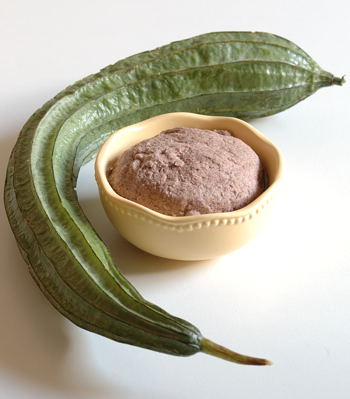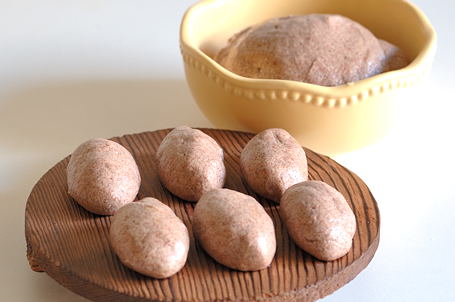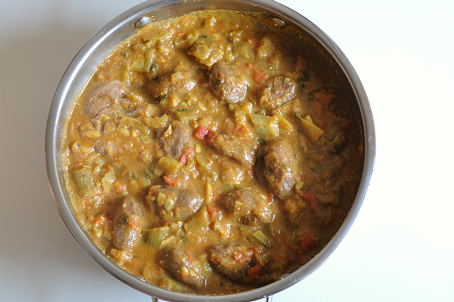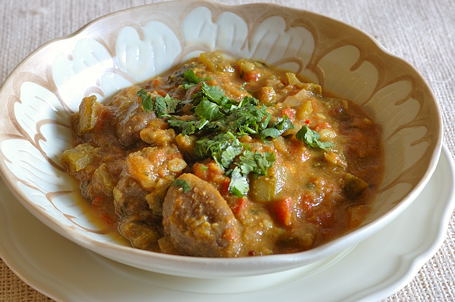Ragi kudumulu is an old classic from Andhra Pradesh, India. Dumplings like kudumulu are prepared with ragi flour and steam-cooked in flavorful kura (curry). The main ingredient of kura in which ragi kudumulu are steamed changes with the seasons. Sometimes the kura is prepared with vegetables, sometimes with meat or a combination. Depends on the cook’s mood and the market prices. Popular in agricultural community, this protein powerhouse is a build or nourish the muscle-on-the-bone kind of one-pot meal.
For Mathy’s Jihva, I have been thinking about a new recipe using garlic-ghee. Then I thought, why not incorporate garlic-ghee into ragi dough and make kudumulu with it. When people say developing new things or techniques is like constantly rediscovering the wheel, it’s very true, indeed. Years of nutritional strategies and accumulated wisdom among cooks throughout the world before us are right to benefit us all through good times and hard times.
Ragi kudumulu is one such nutritional strategy, and here it is in a new avatar. An acquired taste, but a delight to an adventurous palate. Give it a try.

Ridge Gourd and Ragi Dough (Beerakaya mariyu Raagi Mudda)
Recipe:
(for two adults, for two meals)
Recipe happens in three steps. 1. Prepare Ragi dough for Kudumulu.
2. Prepare kura (curry or kurma) for Kudumulu. 3. Prepare kudumulu and steam-cook.
Step 1:
Take one-cup ragi flour in a bowl. Add a tablespoon of garlic-ghee puree and quarter teaspoon salt. Stir in a tablespoon of garlic infused ghee. Sprinkling few tablespoons of hot water, make soft dough. Cover and keep it aside for about 15 to 30 minutes. The dough firms up on resting.
Step 2:
While the ragi dough is resting, prepare kura for ragi kudumulu. It can be with either vegetables, (traditional choice: Indian broad beans, silk squash and ridge gourd), or meat (chicken or mutton). For my meal today, I have prepared Ridge gourd curry (beerakaya kura) for ragi kudumulu.
– – 2 ridge gourds: peel, rinse and cut into ½ inch, big pieces
– – 2 tomatoes and one onion – finely chop to small pieces
Heat a tablespoon of garlic infused ghee in a wide, deep-bottomed skillet. Add and toast a pinch each – cumin and mustard seeds. When seeds start to pop, add the onion. Sauté to soft. Then tomatoes. Add about a cup of water and cook the tomatoes to mush on high heat.
While tomatoes are cooking, prepare the kura masala:
For kura masala: Two tablespoons of grated coconut, 4 green chillies and an inch of peeled ginger, two cloves, one inch cinnamon, a teaspoon each – coriander seeds and cumin. Take them all in a mixer. Add a pinch of salt. Blend to fine consistency.
Tomatoes will be cooked to soft by now. Mush them by pressing with a sturdy spoon. Add the ridge gourd pieces and the masala paste to the skillet. Also half teaspoon each- turmeric and salt. Stir in another cup of water. Close the lid and simmer on medium-low heat.
Step 3:
While kura is cooking, quickly prepare Ragi kudumulu.
Take the ragi dough out onto a plate. Knead and divide into small, about key lime-sized rounds. The dough came about 16 rounds for me. Take a round on your palm, and close the fingers around the round to make a fist. The shape changes to cylindrical with conical ends. That’s what we call “Kudumu†shape in Telugu. Compared to the round shape, the kudumu shape will have more surface area exposed, and that would facilitates thorough steaming. Prepare all rounds in this way. You have to make them fast in two to three minutes.
Place them one after another neatly in simmering kura. Close the lid tightly, and steam for about 15 to 20 minutes on medium-low heat. Ragi kudumulu have to be cooked properly inside. To test, take one out and cut into half. A well-steamed one has the color of red soil (erra mannu) that you see in moderate rainfall areas like Telengana, Andhra Pradesh. On taste, they should have the comforting texture of a well-chewed bubblegum.:) Sticky with unique ragi flavor. The size/volume also increases on steaming.
Garnish with fresh coriander leaves and lime juice. Serve hot. Until serving time, cover the skillet with tight lid and keep the kura hot on low heat.
How to serve: Place four ragi kudumulu in a wide bowl or plate along with vegetable or meat pieces. Pour the tomato-masala gravy around.
How to eat: With fingers or spoon, take a portion of ragi kudumu with kura. Blow to cool for once or twice. Eat. Ragi flour has gummy properties and it would stick to the mouth roof. So don’t chew on the kudumu, just swallow. The masala gravy and vegetables or meat pieces, together they make a memorable meal experience.
Why: Ragi is rich in Iron, minerals and protein, gluten-free, and is known for it’s health benefits. Ragi is cultivated from ancient times in many parts of India, and in fact the name Ragi is a Sanskrit word. So, Ragi consumption means nourishment to the body and also nourishing the traditional agricultural practices.
Here is the preparation process in photos:

Ragi Kudumulu and Ragi Dough

Steamed Ragi Kudumulu in Ridge Gourd Kura

Ragi Kudumulu Flavored with Garlic Ghee in Ridge Gourd Kura ~
Meal today and My Contribution to Mathy’s Garlic-Jihva Event.
Notes:
Ragi flour is available in most Indian grocery shops.
Kudumu is singular and kudumulu is plural in Telugu language.
Traditional Kudumulu from other parts of Bharath:
Jonna (Corn) Kudumulu from En Ulagam
Jowar-wheat Kudumulu from My Food Court
Do you have this type of tradition where kudumulu or dumplings are steam-cooked in the stew itself?
